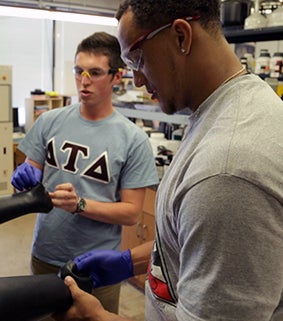Each student who comes to the University of Oregon leads his or her own unique path toward graduation. But along the way, groups form and stereotypes about athletes, Greek members, and academic majors become prevalent.
What would happen if students from various parts of campus spent time shadowing each other? Would those stereotypes be confirmed, or would the students connect over the shared experience of being a Duck?
“Duck Crossing” – a joint project between the Division of Student Life and the Athletic Department – is a series of videos that follow eight students during a week of spring term. Each pair, made up of a student and a student-athlete, share their life at the UO.
Jennifer Truong, a human physiology major, attended lacrosse practice with Chelsea Randal, a family and human services major. Truong went through cardio and weight training with the team. Later, Randal attended a peer advising session and drumming class with Truong.
 Rodney Hardrick, an educational foundation major and football player, accompanied chemistry major Chase Slazer to a Willamette Hall lab for experiments and to a vocal performance at a fraternity. On an early morning at Autzen Stadium, Hardrick showed Slazer how players touch a large metal O on the stadium gate to remember the “Oregon Way and all the guys who come before us.”
Rodney Hardrick, an educational foundation major and football player, accompanied chemistry major Chase Slazer to a Willamette Hall lab for experiments and to a vocal performance at a fraternity. On an early morning at Autzen Stadium, Hardrick showed Slazer how players touch a large metal O on the stadium gate to remember the “Oregon Way and all the guys who come before us.” The students who participated spoke about how all students are working towards leaving a legacy.
“After this experience, it just proves to me how big it is to be at the University of Oregon and how special it is. Not everyone gets that opportunity. It’s about being different, leading the way and making a change. I think that’s the coolest thing to know you’re part of something special,” said Jillian Alleyne, a communications disorders sciences major and basketball player, who paired with Ashley Anderson, a business administration major and intern in the UO Division of Student Life.
In addition, there was a newfound respect for what others go through to be successful.
“There are so many expectation within the structure and in order to excel, it’s a plate-spinning act. It’s weird seeing someone else do the same thing,” said Nolan Kane, a political science and Spanish major who works as an IT manager. He worked with Cole Irvin, a sociology major and baseball player.
“The purpose of the project was to start a conversation about what it means to attend the University of Oregon, and what kind of legacy all students want to achieve while here,” said Jennie Leander, senior associate director of the Services for Student Athletes department. “I think you will see in the videos that each group really had their eyes opened about what each other is accomplishing, both in and out of the classroom.”
The genesis for “Duck Crossing” was discussions between Leander and Katie Harbert of the office of student-athlete development. Those conversations included university staff from academic departments, coalescing around the shadowing concept, and they took off after a discussion between Harbert and Rita Radostitz from the Division of Student Life.
“We know that students on campus have stereotypes about athletes,” said Radostitz. “But we also found that student-athletes have stereotypes about students who don’t play intercollegiate athletics. The project was a great way for everybody to see beyond those stereotypes.”
“There is much discussion about athletics, resources, campus, etc., but it's frequently forgotten that there are real students and people behind those issues,” Leander said. “Again, I think the videos help people see that students and student-athletes have more in common than not. And we think that often gets lost when we talk about only about what makes us different.”
- By Heidi Hiaasen, Public Affairs Communication, with help from Rita Radostitz, Student Life, and Rob Moseley, Athletics

